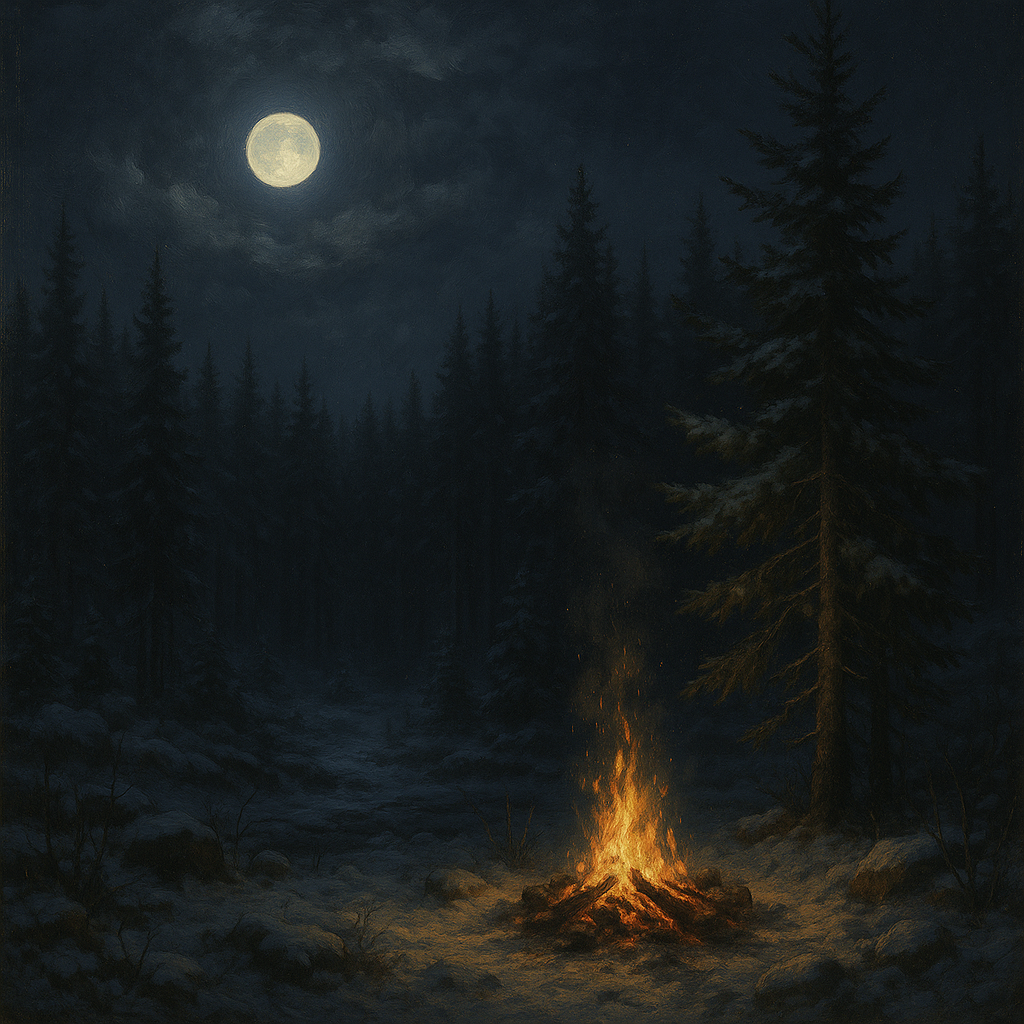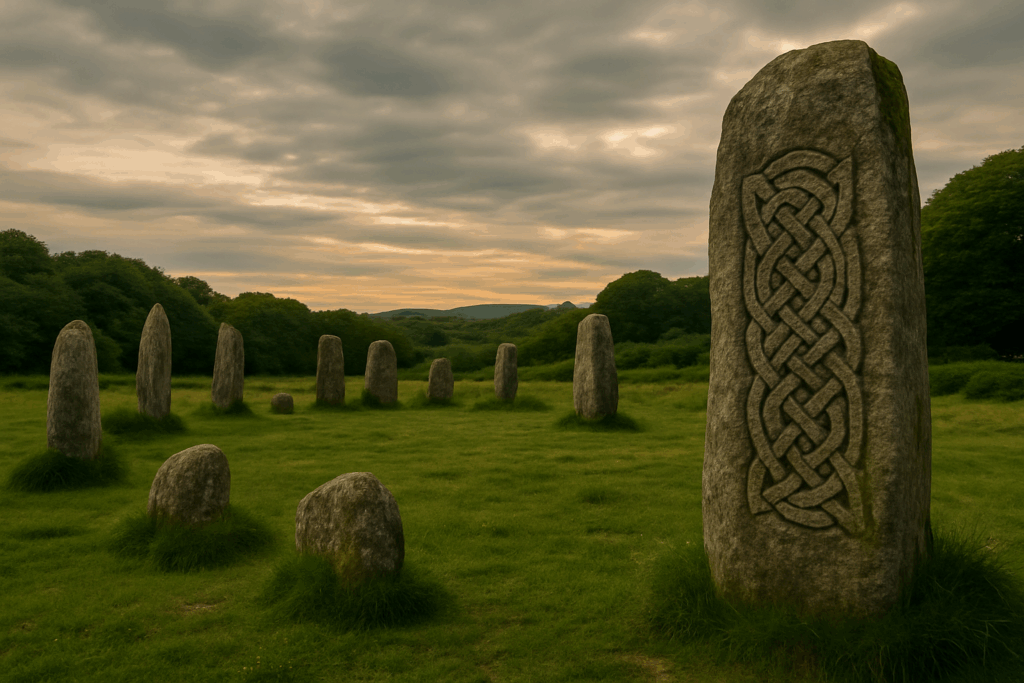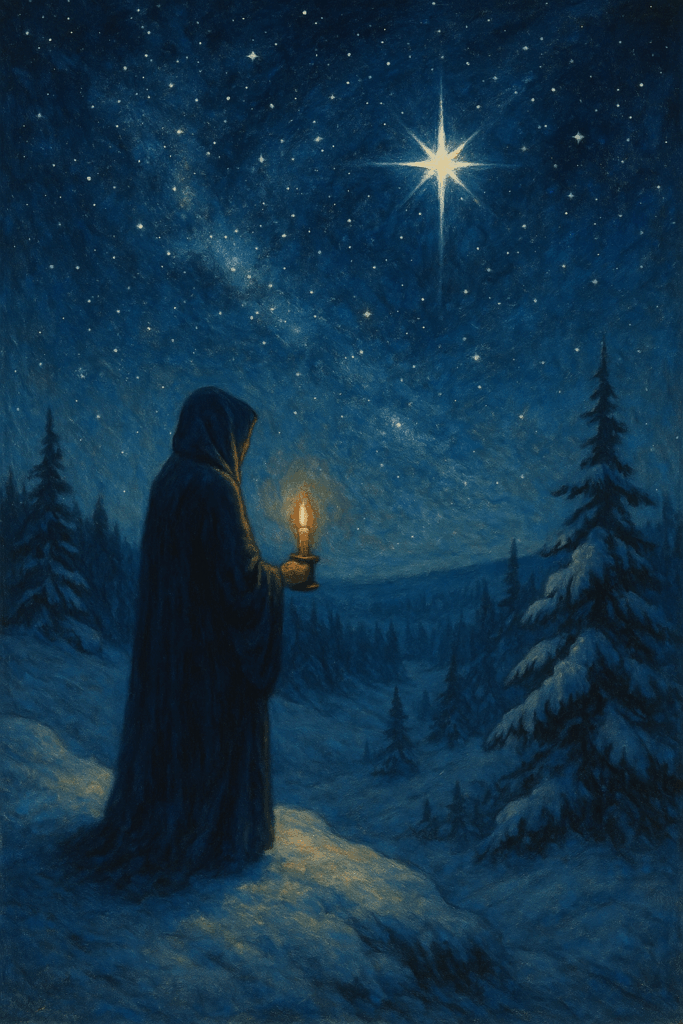🌑 November 21 – The Stag’s Footprint

Following nature’s signs and omens through the cold woods.
The dawn comes pale and breathless. Frost gleams on every twig, every blade of grass; the earth crunches softly underfoot like thin glass. Across the open field, you see them — the tracks of a stag pressed into the frozen soil, elegant and deliberate, winding toward the forest’s edge. The air holds a hush so complete that even your breath seems loud. On this day, November 21, we honor The Stag’s Footprint, the sacred art of reading the language of the wild, of following nature’s omens into understanding.
In ancient lore, the stag was a creature of mystery and revelation. To the Celts, he was Damhnach, the great forest spirit — a guide between worlds, guardian of the greenwood, and herald of transformation. His antlers, rising like branches from his brow, were said to catch the light of other realms. When a stag appeared, it was a message from the unseen: a call to follow, to seek, to awaken. In many myths, the hero’s journey begins with the sighting of such a creature. The stag does not speak, yet his presence commands listening — not with the ears, but with the soul.
The Stag’s Footprint is a meditation on awareness, on reading the signs of the world not as coincidence but as communion. The earth is never silent; it speaks constantly through wind, water, movement, and form. Yet in the rush of modern life, we forget how to listen. This day invites us to slow down, to walk with reverence, and to remember that the world around us is alive with meaning. The stag’s track is not merely an imprint — it is an invitation to presence.
To honor this day, rise early and step into the cold. The air itself will be a teacher. Notice the way it tastes of iron and pine, the way frost etches filigree upon every surface. Walk slowly, breathing in rhythm with your steps. Let your senses awaken one by one — the crunch of leaves, the scent of wood smoke in the distance, the faint stirring of wind in bare branches. You are walking through the oldest of temples, one without walls or roof, where the ground itself bears the scripture of the seasons.
If you find the footprint of an animal — deer, bird, fox, or hare — pause and study it. Let your gaze soften. The track is both sign and story: it tells where the creature has been, what direction it was moving, how swiftly or cautiously it traveled. Every mark upon the earth is an echo of life, a trace of movement, a whisper of will. The stag’s footprint, in particular, holds a regal stillness — deep, firm, symmetrical, like the heartbeat of the forest pressed into soil. It reminds us to move with purpose, to step consciously, to leave behind not chaos but clarity.
Spiritually, The Stag’s Footprint represents the path of intuition — the trail one follows not through reason alone, but through trust in the signs life presents. The Celts believed that omens from nature were not superstitions but communications from the Aos Sí, the spirits of the land. To ignore them was to turn away from the dialogue of creation. If a stag crossed your path, it was said to herald transformation, a threshold soon to be crossed. Its tracks were not to be followed recklessly, but mindfully — for those who followed with respect were often led to truth, while those who pursued out of pride became lost.
The stag’s lesson is patience. He moves with grace and strength, but never haste. He knows when to flee and when to stand still, when to vanish into mist and when to step into light. To walk in his footsteps is to cultivate awareness — to learn that wisdom often comes in quiet signs rather than loud revelations. A fallen feather, a sudden change in wind, a bird’s unusual call — all are messages for those who listen. The Stag’s Footprint teaches that the sacred does not speak in words, but in patterns, rhythms, and moments of perfect coincidence.
If you wish to perform a ritual this day, let it be one of observation. Venture into a natural space — a forest path, a park, even a garden touched by frost. Bring nothing to control the experience; bring only your awareness. Walk slowly, allowing your gaze to soften, your breath to deepen. When you find a footprint or sign — a track, a trail, a branch broken just so — pause and ask inwardly, What is this showing me? Do not expect language; expect sensation. The answer may come as an emotion, a memory, or a subtle clarity. Perhaps the message is about direction, patience, release, or courage. Let nature’s wisdom reach you through the language of experience.
You may also wish to meditate with the image of the stag itself. Picture it standing in a snowy clearing, antlers illuminated by the faint winter sun. Its breath steams in the air, its eyes calm and knowing. In that gaze lies the wild soul of the world — free, unbroken, eternal. As you breathe, imagine drawing strength from its presence. The stag’s antlers, renewed each year, remind us of regeneration, of the power to shed the old and grow again. His sure steps through the forest mirror our own path through life’s uncertainty.
In Celtic symbolism, the stag also embodies sovereignty — the rightful power that comes from harmony with the land. To follow the stag’s footprint is to align oneself with integrity, to act with honor and balance. The kings of old were said to hunt not to conquer, but to commune; their pursuit of the white stag represented the quest for divine guidance. In this spirit, let your own pursuit be inward — a quest for alignment with the greater rhythm of existence.
The stag’s energy is also deeply masculine, but not in dominance — in guardianship. He represents a power that protects rather than conquers, that leads through grace rather than force. Yet he also belongs to the feminine, for the forest is his mother and the moon his keeper. In his being, the polarities unite. To meditate upon him is to find harmony within yourself — between action and stillness, strength and gentleness, instinct and intuition.
As the day wanes, return home and light a single candle in honor of the wild. If you gathered a small stone, twig, or leaf from your walk, place it beside the flame. This becomes your Footprint Altar — a reminder that guidance is always around you, if only you slow down to see it. Whisper a quiet invocation:
“Spirit of the Stag, guide my steps.
Let me walk in awareness,
Reading the language of the earth,
Living in harmony with her signs.”
Sit in the candlelight for a while, allowing your thoughts to still. You may find that memories of the day’s small details return — a bird’s flight, a gust of wind, the pattern of frost on a window. These, too, are omens, fragments of conversation between you and the living world. Let gratitude fill you for this dialogue, this intimate connection that is your birthright.
When you step outside once more before sleep, the air will be colder, the stars sharper. Perhaps, in the distance, you will imagine the faint sound of hooves on frozen ground — a soft rhythm fading into the woods. That is the Stag’s Footprint: the sign that you have entered the rhythm of the wild once more, that the boundary between you and the living world has grown thin.
The Stag’s Footprint teaches that guidance is not always sought; often, it is found in stillness, in the subtle marks life leaves for us to discover. The path ahead is always written — in snow, in soil, in breath, in stars. All we must do is look down, listen, and follow.



